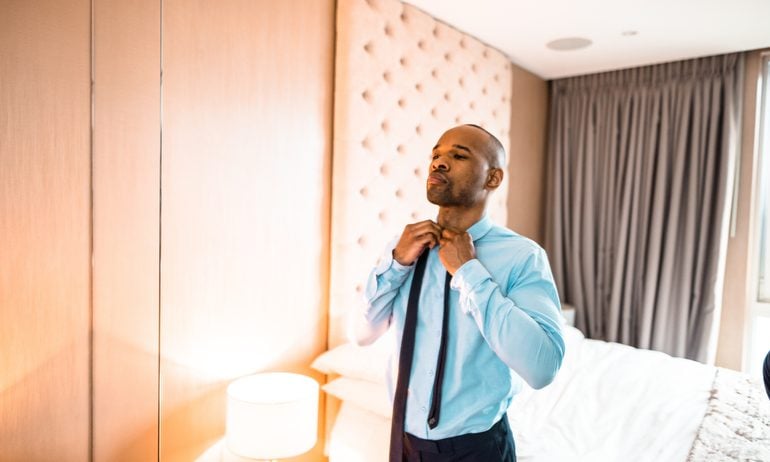What to Wear to Any Interview: A Guide
Within the company’s dress code, wear something that makes you feel confident.

Many, or all, of the products featured on this page are from our advertising partners who compensate us when you take certain actions on our website or click to take an action on their website. However, this does not influence our evaluations. Our opinions are our own. Here is a list of our partners and here's how we make money.
There’s no universally right or wrong way to dress for an interview. It’s all about wearing crisp, clean clothing that matches the employer’s dress code and expectations, experts say.
Below, we’ll discuss how to pick your interview attire, the different types of professional dress codes and what to avoid wearing to an interview.
What to wear to an interview
Check the company’s dress code when deciding what to wear to an interview, recommends Purdue Global, an online university in the Purdue University system.
Look for photos of employees, either in the office or in a company photo, on the company’s website or LinkedIn page. Note how they're dressed and whether they’re posing formally or casually.
Unless its employees wear a uniform, most companies adhere to one of these three dress codes: smart casual, business casual or business professional.
Consider the industry you’re interviewing in. Companies in law, finance or politics tend to adhere to more traditional dress codes. Tech or media companies tend to have more casual dress codes.
If you’re interviewing for a job that would require a uniform, including in a retail, restaurant, gym or medical setting, opt for business casual for those job interviews, recommends Coursera, a company that hosts open courses from universities and organizations online.
Dress for a position one level higher than the job you’re interviewing for, experts recommend. So, if most employees wear chinos and a casual button-down shirt, for example, go for slacks, a tucked-in shirt and a blazer.
Ask your interviewer about the company’s dress code if you’re still unsure of what to wear. If you’re working with a recruiter, you can plainly ask for advice on what to wear to an interview.
If you’d be asking the company’s hiring manager, consider asking, “How do employees dress in the office?” or “What kind of clothing is appropriate for this workplace?”
What is a smart casual dress code?
Smart casual is the most informal of the three professional dress codes. It emerged in recent years as more companies loosened their dress codes, per the Society for Human Resource Management.
Smart casual is relaxed but polished. You could wear trendier clothing and accessories from your personal wardrobe as long as they're fit for a professional environment.
Companies in newer or creative industries — such as tech, media or advertising — may adhere to this dress code. Examples of smart casual workwear include:
Well-fitting pants — chinos, pleated pants or linen pants.
Dark blue or black jeans.
Sweaters, henleys, button-up shirts, or trendy blouses.
Loafers, flats or clean tennis shoes.
A clean, ironed T-shirt under a blazer.
Solid colors or stylish patterns.
What is a business casual dress code?
Business casual is more formal and conservative than smart casual but still doesn’t require you to wear a full suit.
Businesses across many different industries adhere to this dress code. It’s a popular dress code among employers and is considered appropriate for job fairs, networking events or professional meetings.
Business casual workwear can look like:
Chinos, khakis or dress pants and a belt.
A clean button-up, dress shirt, formal blouse or tucked-in polo shirt.
Closed-toe shoes, like Oxfords, brogues, loafers or flats.
A blazer.
Solid, neutral colors with minimal patterns.
What is a business professional dress code?
Business professional is the dressiest of the professional dress codes.
Older, more traditional industries — such as law, finance, professional services or politics — tend to adopt a business professional dress code. Executives and other high-ranking employees may also adhere to this dress code.
Some examples of business professional workwear include:
A suit and dress shirt.
Tailored pants, a dress shirt and a tie.
A dressy business skirt and formal blouse.
Heels, dress shoes or formal loafers.
Conservative, non-distracting jewelry and accessories.
Dark, solid colors, such as blue, black or gray.
What not to wear to an interview
Unless you’re interviewing at a beachside surf shop, avoid these items of clothing, according to Zippia, an online recruiting and careers platform:
Graphic T-shirts.
Shorts.
Casual sandals or flip flops.
Tank tops or sleeveless shirts.
Athleisure, sweats or pajamas.
Ripped jeans or pants.
The quality of your clothing is also important. Don’t wear items that:
Are stained or soiled.
Have holes or tears.
Are unwashed or dirty.
Are visibly old, faded or worn.
Outside of your clothing, pay close attention to your personal grooming. Career experts recommend you run through this checklist list before you leave for the interview:
Hair is brushed or neatly combed and styled.
Fingernails are clean.
Deodorant has been applied.
Shoes are clean and free of mud or dirt.
One more tip
It’s important to wear clothing that aligns with the employer’s dress code, but that’s not the only thing that matters.
What you wear can help you feel comfortable and confident. And wearing clothing that shows off your personality can help people at the company get to know you.
So, if you feel a yellow blouse mirrors your sunny disposition, go for a shade that’s cheery but not neon. Striking that right balance can be tricky but it’s worth the effort. It’s like the old saying goes: look good, feel good.

